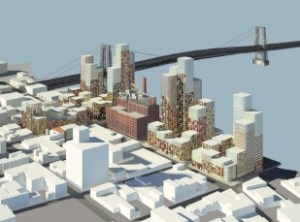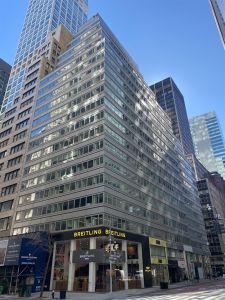At New Domino, Affordable Housing Promise More of a Pledge
By Eliot Brown July 27, 2010 2:25 pm
reprints The Post‘s Rich Calder has a piece following up on the Domino Sugar deal in Brooklyn, in which developer CPC Resources won the approval to build 2,200 apartments by the Williamsburg waterfront, promising at the time to build 30 percent of them at below-market rates. This promise was absolutely integral to the City Council’s eventual approval of the project.
The Post‘s Rich Calder has a piece following up on the Domino Sugar deal in Brooklyn, in which developer CPC Resources won the approval to build 2,200 apartments by the Williamsburg waterfront, promising at the time to build 30 percent of them at below-market rates. This promise was absolutely integral to the City Council’s eventual approval of the project.
But, as the Post notes, the deal is not an ironclad one. With the zoning text only requiring 20 percent, the developer has simply signed a Memorandum of Understanding with the city in which it pledged to do the full 30 percent subsidized housing.
From the Post:
However, city officials confirmed that when the City Council votes Thursday on the controversial project’s needed zoning change, the zoning amendment’s text will include standard language of the city’s Inclusionary Zoning policy – thus guaranteeing that only 20 percent of the units will be set aside for low- and moderate-income residents. In Domino’s case, that translates into just 440 affordable units.
The 30-percent affordable-housing promise, however, has been memorialized in a “Memorandum of Understanding” that both the city and the development team of CPC Resources and Isaac Katan recently signed off on. However, as even the document notes, it is a non-binding agreement.
This is probably a less than satisfactory answer for many of the project’s critics, who recently were questioning just how the developer would guarantee that it would deliver on the affordable housing. And while CPC may indeed be earnest in its statements (and there may be some incentive from the city to do the 30 percent), the MOU is not binding, nor does it tie the next owner of the site (should CPC ever sell it off) to the project.
Alas, this resembles the groundwork of many a development project in New York. While a good number of developers do end up delivering on promises, other projects are sold to the public on the promise of certain public benefits (in exchange, the public’s representatives grant approvals), only to see those benefits eroded over time as they prove difficult or impossible to fulfill. A couple other case studies to look at: Battery Park City, once meant to be mostly below-market rate housing; and Atlantic Yards once meant to have a green roof and a Frank Gehry-designed arena.


